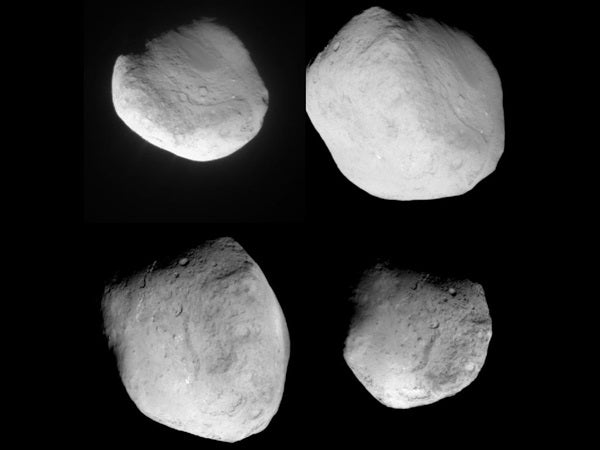NASA’s Stardust spacecraft returned new images of a comet showing a scar resulting from the 2005 Deep Impact mission. The images also showed the comet has a fragile and weak nucleus.
The spacecraft made its closest approach to Comet Tempel 1 on Monday, February 14, at 11:40 p.m. EST at a distance of approximately 111 miles (178 kilometers). Stardust took 72 high-resolution images of the comet. It also accumulated 468 kilobytes of data about the dust in its coma, the cloud that is a comet’s atmosphere. The craft is on its second mission of exploration called Stardust-NExT, having completed its prime mission collecting cometary particles and returning them to Earth in 2006.
The Stardust-NExT mission met its goals, which included observing surface features that changed in areas previously seen during the 2005 Deep Impact mission, imaging new terrain, and viewing the crater generated when the 2005 mission propelled an impactor at the comet.
“This mission is 100 percent successful,” said Joe Veverka, Stardust-NExT principal investigator of Cornell University in Ithaca, New York. “We saw a lot of new things that we didn’t expect, and we’ll be working hard to figure out what Tempel 1 is trying to tell us.”
Several of the images provide tantalizing clues to the result of the Deep Impact mission’s collision with Tempel 1.
“We see a crater with a small mound in the center, and it appears that some of the ejecta went up and came right back down,” said Pete Schultz of Brown University in Providence, Rhode Island. “This tells us this cometary nucleus is fragile and weak based on how subdued the crater is we see today.”
Engineering telemetry downlinked after closest approach indicates the spacecraft flew through waves of disintegrating cometary particles, including a dozen impacts that penetrated more than one layer of its protective shielding.
“The data indicate Stardust went through something similar to a B-17 bomber flying through flak in World War II,” said Don Brownlee, Stardust-NExT co-investigator from the University of Washington in Seattle. “Instead of having a little stream of uniform particles coming out, they apparently came out in chunks and crumbled.”
While the Valentine’s Day night encounter of Tempel 1 is complete, the spacecraft will continue to look at its latest cometary obsession from afar.
“This spacecraft has logged over 3.5 billion miles [5.6 billion km] since launch, and while its last close encounter is complete, its mission of discovery is not,” said Tim Larson, Stardust-NExT project manager at JPL. “We’ll continue imaging the comet as long as the science team can gain useful information, and then Stardust will get its well-deserved rest.”
The latest Stardust-Next/Tempel 1 images are online at: http://www.nasa.gov/mission_pages/stardust/multimedia/gallery-index.html
NASA’s Stardust spacecraft returned new images of a comet showing a scar resulting from the 2005 Deep Impact mission. The images also showed the comet has a fragile and weak nucleus.
The spacecraft made its closest approach to Comet Tempel 1 on Monday, February 14, at 11:40 p.m. EST at a distance of approximately 111 miles (178 kilometers). Stardust took 72 high-resolution images of the comet. It also accumulated 468 kilobytes of data about the dust in its coma, the cloud that is a comet’s atmosphere. The craft is on its second mission of exploration called Stardust-NExT, having completed its prime mission collecting cometary particles and returning them to Earth in 2006.
The Stardust-NExT mission met its goals, which included observing surface features that changed in areas previously seen during the 2005 Deep Impact mission, imaging new terrain, and viewing the crater generated when the 2005 mission propelled an impactor at the comet.
“This mission is 100 percent successful,” said Joe Veverka, Stardust-NExT principal investigator of Cornell University in Ithaca, New York. “We saw a lot of new things that we didn’t expect, and we’ll be working hard to figure out what Tempel 1 is trying to tell us.”
Several of the images provide tantalizing clues to the result of the Deep Impact mission’s collision with Tempel 1.
“We see a crater with a small mound in the center, and it appears that some of the ejecta went up and came right back down,” said Pete Schultz of Brown University in Providence, Rhode Island. “This tells us this cometary nucleus is fragile and weak based on how subdued the crater is we see today.”
Engineering telemetry downlinked after closest approach indicates the spacecraft flew through waves of disintegrating cometary particles, including a dozen impacts that penetrated more than one layer of its protective shielding.
“The data indicate Stardust went through something similar to a B-17 bomber flying through flak in World War II,” said Don Brownlee, Stardust-NExT co-investigator from the University of Washington in Seattle. “Instead of having a little stream of uniform particles coming out, they apparently came out in chunks and crumbled.”
While the Valentine’s Day night encounter of Tempel 1 is complete, the spacecraft will continue to look at its latest cometary obsession from afar.
“This spacecraft has logged over 3.5 billion miles [5.6 billion km] since launch, and while its last close encounter is complete, its mission of discovery is not,” said Tim Larson, Stardust-NExT project manager at JPL. “We’ll continue imaging the comet as long as the science team can gain useful information, and then Stardust will get its well-deserved rest.”
The latest Stardust-Next/Tempel 1 images are online at: http://www.nasa.gov/mission_pages/stardust/multimedia/gallery-index.html










